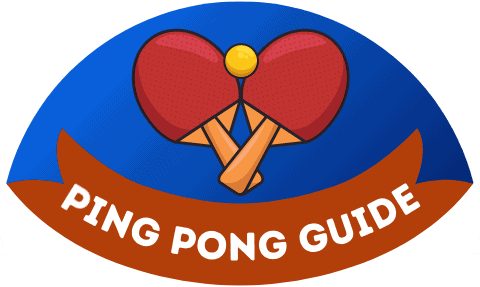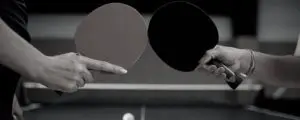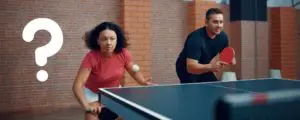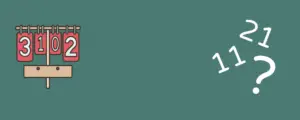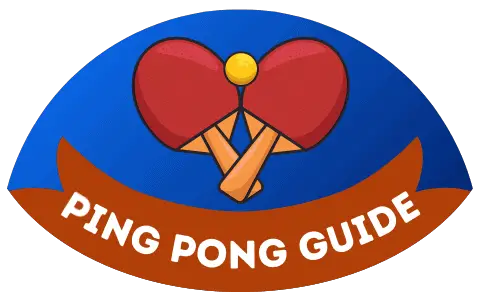The stars on ping pong balls have probably caught the eye of many hobby players. Perhaps you have already wondered what they actually mean. One quickly comes to the thought – “It must have something to do with the quality”. That’s exactly how I felt. However, I would not have been able to explain what exactly the stars are for. For this reason, I have done some research and explain the exact differences in this post.
The stars on table tennis balls indicate the different quality levels. Only 3-star balls are approved to be used in official matches. Only they meet the official quality requirements of the table tennis federation ITTF. 1-star and 2-star balls fall off significantly in terms of durability, hardness, balance, elasticity, and roundness. Therefore, they are mainly used as training balls.
That was the short answer. However, this still does not clarify the specific points in which the quality levels differ and what exactly qualifies a 3-star ball.
Are You Looking for Great Table Tennis Balls?
Recommendation: For balls, it’s best to go straight to the top shelf. This set of 12 JOOLA 3-star tournament balls is available for less than $10 – My absolute favorite balls!
What Distinguishes a 3-Star Ball from the Others?
Ping pong balls must meet the quality requirements of the ITTF to earn 3 stars. Only these balls are approved for official competitions. Every year, new and existing models are closely examined for this purpose. Currently, 96 different balls of several brands are allowed to carry the 3 stars. You can find the official list here. And these are the characteristics they have to fulfill:
- Material: New table tennis balls are no longer made celluloid but of plastic.
- Size: The ideal ball has a diameter of 40mm. 3-star balls may deviate by 0.5mm. This means that each ball is between 39.5mm and 40.5mm thick.
- Weight: The weight must be between 2.67 and 2.77 grams. Ideal would be 2.7 grams
- Roundness: A ping pong ball should of course be as round as possible. For this purpose, the difference of the diameter minimum to the maximum is measured. This must not be more than 0.25 millimeters for new balls that are made of plastic. The shape of the ball is also checked by another test. It is checked that the balls roll straight when rolling down a slope and do not tilt in one direction.
- Bounce: 3-star balls should bounce properly, of course. If they are dropped from 30.5 cm, they must bounce at least 24 cm and at most 26 cm.
- Hardness: The balls are tested for hardness by computer controlled devices. Unfortunately I could not find any information about the exact values they have to reach.
- Color: Table tennis balls may only be matte white or matte orange.
- Labels: New plastic balls are marked with “40+”. On older balls you can still find the signs “40” or “40mm”.
When it comes to competition balls, obviously nothing is left to chance. But how much worse are balls that can’t quite match the quality requirements?
1-Star Balls
1-Star balls, if they are still in use, are used mostly for training. Due to the inferior quality, they are logically cheaper and are sold in larger quantities. They are by far the softest balls and therefore break down more quickly. However, I have repeatedly read that they are quite suitable for children and beginners because they do not bounce as high.
For most hobby players, 1-star balls are perfectly fine. In my opinion, however, the small surcharge for 3-star balls is worth it already for players of a slightly advanced level.
2-Star Balls
2-star balls only just fail to meet the requirements for the 3 stars described above. This means that the vast majority of players will not notice much difference. Usually, these are a lot firmer than the balls with only one star and therefore last much longer.
So if you have 2-star balls at home, that’s usually enough. However, if you want to buy a new set of balls, I don’t see why you shouldn’t buy 3-star balls instead of 2-star, since they don’t differ so much in price and the latter last longer and is just a bit better.
3-star balls
The reason why competition balls must be of the highest quality is obvious. The ball must not be a factor. It must always behave the same way on the same swing – even with smashes of over 170 Km/h. Even the slightest deformation could therefore decide matches. This is why 3-star balls are tested so thoroughly before they are approved for competition.
I play often but not at a competitive level. Nevertheless, I only use 3-star balls, because only there I can be sure that a mistake or even a point is only due to me and my technique and not the ball.
What about Balls with no Stars?
These balls do not have to meet any quality requirements at all. Thus, of course, they can differ extremely. In my experience, most of them are not even suitable for a decent training match (although you can certainly work on your reflexes quite well due to the not quite round shape). However, the balls are completely adequate for party games like Beer Pong 😄.
What about Balls with 4 or even 5 stars?
Quite importantly, only the 3-stars are tested and regulated by the ITTF as a seal of approval. Otherwise, manufacturers can of course print whatever they want on their balls. Therefore you can find balls with more than 3 stars from time to time. For example, I have often seen some with 4 or even 5 stars. Please do not fall for it! Of course, these balls do NOT meet the official standard and are NOT better than balls with 3 stars. At the current time, 3 stars guarantee the best possible quality.
Which balls do I need as a recreational player?
I am not a professional myself, but I play my matches against family, friends, and colleagues exclusively with 3-star balls. In my opinion, they are worth the extra cost because they are the most reliable balls to play with. If you handle them well, don’t lose them, and (very important!) do not step on them, they will last an extremely long time. If you need a lot of balls for certain exercises and game modes, I would go for multipacks of 1-star balls. They don’t last as long, but you have a lot of them. At the moment, only 1-star and 3-star balls are really used. This is also the case with various coaching sites that I have read through for this article.
Which Balls do I recommend?
As mentioned, I play exclusively with 3-star balls and am very satisfied with them. Only very rarely do I lose a ball and therefore I haven’t had to buy a new set for a long time.
With this 3-Star ball, you are on the safe side as a hobby player: Competition Balls
Training ball: 3-Star Training Balls
I myself do not play with 1-star balls as a training ball. But if I had to buy some, it would be these: 1-Star Training Balls
